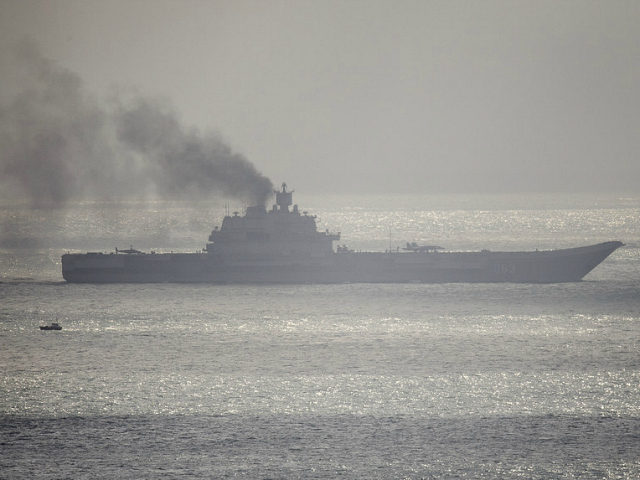The Kremlin Navy’s combat power amounts to less than half of the capability of its U.S. counterpart, the National Interest reported over the weekend, citing an assessment by a Russian web site.
Flot.com’s analysis showing that the Russian Navy is falling behind comes a couple of months after the top U.S. admiral in the Indo-Pacific region warned China’s modernization efforts are “eroding” the United States’ “relative competitive military advantage” in the area.
In recent months, the U.S. military and intelligence community have warned about increasing cooperation between China and Russia.
On Sunday, the National Interest reported:
The Russian Navy’s combat capability was just 45 percent of the U.S. Navy’s according to an analysis by flot.com, a Russian defense Web site [English translation here]. This is down from 47 percent in 2017 and 52 percent in 2014.
Exactly how these metrics were calculated isn’t clear, but it appears the United States is ahead in the rankings because it is building bigger ships than Russia is. In theory, 2018 should have been a good year for the Russian Navy, which received seven ships, including the powerful frigate Admiral Gorshkov.
“Compared to the almost failed year of 2017, when the Russian Navy received two warships and an icebreaker, the past year was productive for domestic shipbuilding,” flot.com reportedly acknowledged.
The National Interest stressed that the U.S. Navy is more potent than Russia’s. However, last year’s Global Firepower (GFP) index cautioned that the militaries of China and Russia together could outrank the U.S. armed forces, which are considered the most powerful in the world.
On Sunday, the National Interest noted:
Today, the U.S. Navy argues that it lacks enough ships to perform its missions, such as preparing for war with China or Russia. Its admirals worry about new threats such as hypersonic Russian and Chinese anti-ship missiles. But to Russia, whose navy can only envy America’s fleet of eleven giant aircraft carriers, the enemy must seem powerful and well-funded indeed.
In 2018, Adm. Harry Harris, the PACOM chief, warned that China’s “impressive military buildup” may soon enable the Chinese military to challenge America’s dominance in the Indo-Pacific region “across almost all domains.”
Beijing has already “developed and fielded capability and capacity to challenge our regional maritime dominance,” he declared.
U.S. Pacific Command (USPACOM) heavily relies on the American navy to carry out its activities in its area of responsibility, which “includes the world’s busiest international sea lanes and nine of the ten largest ports.”
Under U.S. President Donald Trump, the American military is prioritizing combating strategic competitors Russia and China over the war on terror.
On Monday, America’s enemy Iran announced that it will stage a naval exercise in the Persian Gulf this year with its ally Russia.
“Rear-Admiral Hossein Khanzadi made the announcement during a press conference on Monday upon return to Tehran from a high-profile visit to China, where he met with his counterparts from other countries,” Iran’s state-run Press TV noted.
The U.S. military has warned that China is cozying up to Iran.
Late last year, Tehran threatened to blockade the Persian Gulf if the United States moved to suspend the waivers and tries to prevent Tehran from exporting its crude oil.
The Trump administration did move last week to end sanction waivers granted to some of Tehran’ biggest oil customers, including China. In response, Iran struck a defiant tone saying the United States could never stop them from exporting oil.

COMMENTS
Please let us know if you're having issues with commenting.